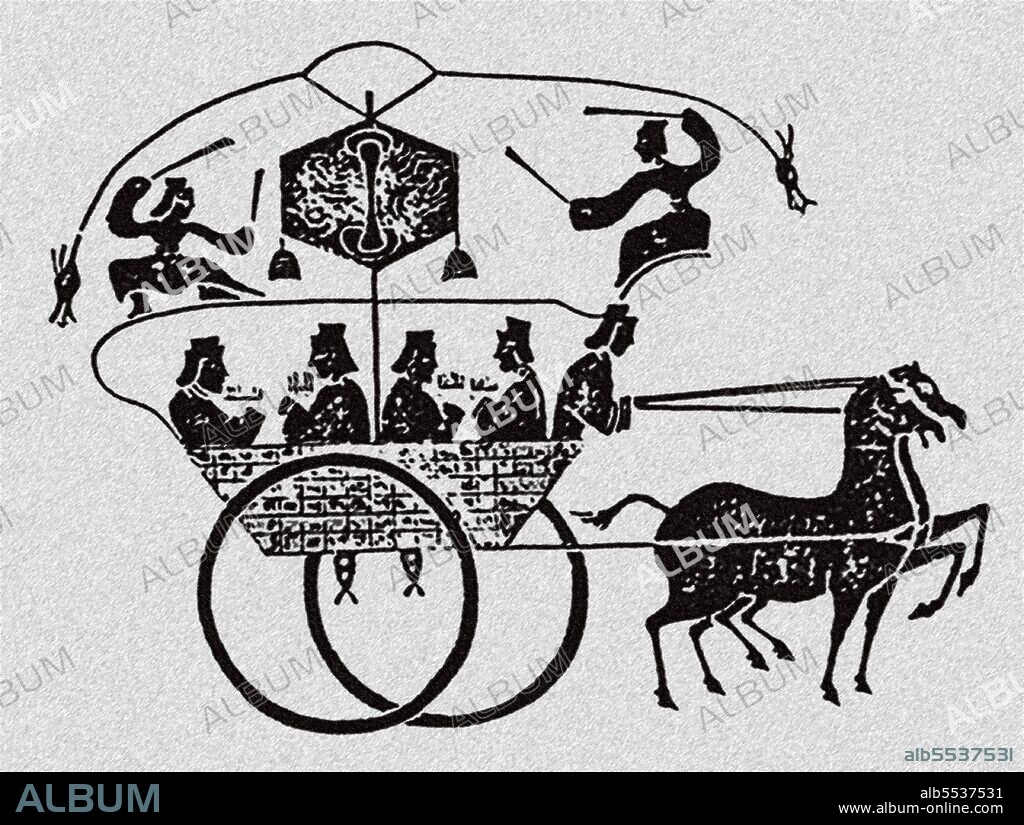alb5537531
China: An early Chinese odometer represented in a stone rubbing from the Xiaotang Shan Han Mu Ci, Shandong Province, c. 125 CE

|
Add to another lightbox |
|
Add to another lightbox |



Buy this image.
Select the use:

Title:
China: An early Chinese odometer represented in a stone rubbing from the Xiaotang Shan Han Mu Ci, Shandong Province, c. 125 CE
Caption:
The Xiaotang Mountain Han Shrine (Chinese: ??????; pinyin: Xiàotáng Shan Hàn Mù Cí) also known as the Guo Family Ancestral Hall (Chinese: ????????; pinyin: Xiàotángshan Guo Shì Mù Shí Cí, literally 'Xiaotang Mountain Guo Family Tomb Stone Ancestral Hall') is a funerary stone shrine from the early Eastern Han Dynasty (25-220 CE) situated on slopes of the Yellow River valley in the western part of Shandong Province, China. An odometer for measuring distance was first described by Vitruvius around 27 and 23 BCE, although the actual inventor may have been Archimedes of Syracuse (c. 287 BC – c. 212 BCE) during the First Punic War. The odometer was subsequently developed in ancient China, possibly by the profuse inventor and early scientist Zhang Heng (78 CE – 139 CE) of the Han Dynasty (202 BCE–220 CE). Zhang Heng is often accredited with the invention of the first odometer device in China. By the 3rd century (during the Three Kingdoms Period), the Chinese had termed the device as the 'jì li gu che' (????), or 'li-recording drum carriage'. Chinese texts of the 3rd century tell of the mechanical carriage's functions: As one li (c.500 metres) was traversed, a mechanical-driven wooden figure struck a drum, and when ten li was traversed, another wooden figure struck a gong or a bell with its mechanically-operated arm.
Credit:
Album / Pictures From History/Universal Images Group
Releases:
Image size:
4800 x 3621 px | 49.7 MB
Print size:
40.6 x 30.7 cm | 16.0 x 12.1 in (300 dpi)
Keywords:
ART • ARTS • ASIA PICTURES • ASIA • ASIAN IMAGE • ASIAN IMAGES • ASIAN PICTURES • ASIAN • BAS RELIEF • BAS-RELIEF • BOZZETTO • CART • CHINA • CHINE • CHINESE • CIENCIA • CIVILISATION • CIVILIZATION • DESIGNING • DRAWING • DRAWN • EQUUS CABALLUS • HISTORIA UNIVERSAL • HISTORIA • HISTORICAL IMAGES • HISTORICAL PICTURES • HISTORICAL • HISTORY IMAGES • HISTORY PICTURES • HISTORY • HISTORY. • HODOMETER • HORSE'S • HORSE • HORSES HORSE • HORSES • INVENTIONS • LEGEND • MILIOMETER • ODOMETER • PORCELAIN • RELIEF • RUBBING • SCIENCE AND CIVILISATION • SCIENCE • SCIENCES • SHANDONG • SKETCH • XIAO TANG TONMB • ZHANG HENG


 Pinterest
Pinterest Twitter
Twitter Facebook
Facebook Copy link
Copy link Email
Email
